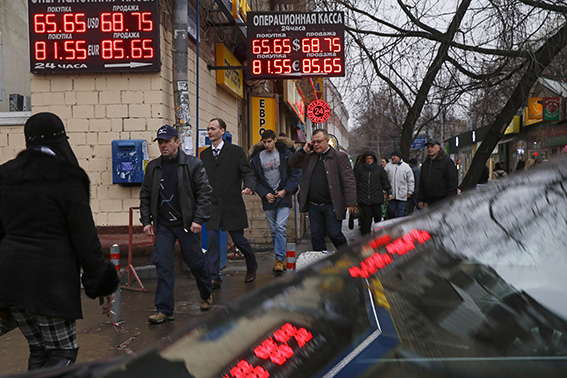The Russian economy has been surprising to the upside in recent months, although that assessment is conditioned heavily by the fact that “upside” really means lower rate (than expected) of economic decline and stabilized oil prices at above $55 per barrel threshold.
On the former front, Q1 2015 decline in real GDP is now estimated at 2.2% y/y – well below -3% official forecast (reiterated as recently as on April 1) and -2.8% contraction forecast just last week, and -4.05% consensus forecast for FY 2015. It is worth noting that contraction in GDP did accelerate between February (-1.2% y/y) and March (-3.4% y/y). Q2 2015 forecast remains at -3%, Seeking Alpha reported.
In line with this, there have been some optimistic revisions to the official forecasts. The Russian Economy Ministry has released yet another (fourth in just two months) forecast with expected GDP decline of 2.8% this year. Crucially, even a 2.8% decline forecast figure still assumes oil price of $50/barrel. Similarly, the Economy Ministry’s latest forecast for 2016 continues to assume oil at $60/barrel, but now estimates 2016 GDP growth at +2.3%.
Investment Objective
These are central estimates, absent added stimulus. In recent weeks, the Russian government has been working on estimating a possible impact of using up to 80% of the National Welfare Fund reserves to boost domestic infrastructure investment. This is expected to form the 3-year action plan to support economic growth that is expected to raise domestic investment to 22-24% of GDP by 2020 from the current 18%.
The objective is to push the Russian growth toward 3.5-4% mark by 2018 while increasing reliance on private enterprise investment and entrepreneurship to drive this growth.
And in line with this (investment) objective, the CBR (Central Bank of Russia) cut its key rate this week by 150bps to 12.5%.
According to Bank of Russia estimates, as of April 27, annual consumer price growth rate stood at 16.5%. High rates of annual inflation are conditioned primarily by short-term factors: ruble depreciation in late 2014 - January 2015 and external trade restrictions.
Meanwhile, monthly consumer price growth is estimated to have declined on the average to 1.0% in March-April from 3.1% in January-February, and annual inflation tends to stabilize. Lower consumer demand amid contracting real income and ruble appreciation in the recent months curbed prices. Inflation expectations of the population decreased against this backdrop.
Current monetary conditions also facilitate the slowdown in consumer price growth. Money supply growth rate remains low. Lending and deposit rates are adjusted downwards under the influence of previous Bank of Russia decisions to reduce the key rate.
However, they remain high, on the one hand, contributing to attractiveness of ruble savings, and, on the other hand, alongside with tighter borrower and collateral requirements, resulting in lower annual lending growth.


